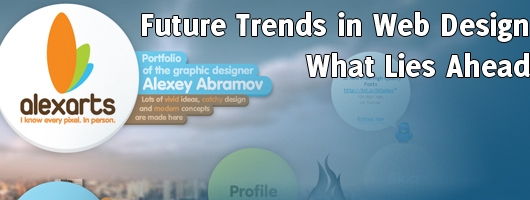It’s no secret that the web is evolving rapidly, much faster than we can keep pace with it. No sooner does something become the rage than it’s replaced by something else at the top; in short, the Internet is transient and keeps morphing into new forms and taking on new avatars every now and then. The change is driven by the motivation to push for more – we want more automation, more sophistication, and more intuition in the way the web serves us. We want to do less, and at the same time, want the Internet to give us more. And as the web evolves from one form to another seamlessly, it follows that websites too are going to have to change if they don’t want to be classified outdated and irrelevant. So how drastically will website design change?
1. Horizontal Websites
We’ve already see the advent and popularity of horizontal websites, a new trend as far as the design aspect is concerned. Navigation is from side to side rather than up and down, and this kind of design works well for sites that feature multiple small blocks of content rather than long stretches of text; sites that feature photographs and graphics would prefer to go horizontal because of the convenience this design factor offers.

2. Multi-Column Layouts
We’re also looking at multi-column layouts which allows designers to fit more text into less space; this way, visitors don’t have to scroll up and down to read the entire text because it fits perfectly into one frame that’s been divvied into columns that improve readability and facilitate easy assimilation of the information.
3. Larger Photographs
With the advent of high speed Internet, more and more designers are opting to include large photographs in their pages knowing that the pictures are not going to increase page load times and that they make a positive impact on visitors.

4. Less is More
Designers are also beginning to realize that less is more – no longer do we have annoying design aspects like graphics that are completely unnecessary to the design cluttering up the page and no longer do designers feel the need to use every single design tool at their disposal in the building of a site.

And finally, we’re seeing more utility value in websites with web-masters realizing that unless they’re able to link their content with their design, their site is going to look and feel lopsided. No longer do gray hat SEO techniques of stuffing keywords randomly into long stretches of text do the trick; as search engines become more sophisticated, websites know they cannot cheat them into pushing them to the top of their ranks. So good web design has to incorporate good writing as well if the site wants to be around and do well in the long term.

thanks your great article
Thank you for posting such a beautiful blog i like this blog and i want to subscribe it so can you please tell me when you blog gets updated.
I’m definitely looking forward to the Less Is More and Larger Photographs trends in web design. Hooray for web design that is simple yet functional. No unnecessary design elements cluttering the page. And ever thankful for high speed internet that allows for large, high resolution images in sites without significantly slowing page load time. Thanks!
i like way of representation….
What a great article. Thank you for taking the time to write it. I found a few nuggets in here that will help me out.
Hi,
Great article Nikhil, Keep posting intresting stuff as you are always.
You shared a great side of future of web designing where it will be going in future and how it will benefit clients and make designers flexible to adapt such changes…